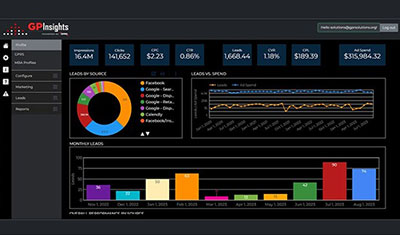The First 24 Hours Matter Most: How ReadyRecruit.ai Qualifies Leads Instantly
 Every enrollment leader knows this truth: the fastest institution to respond has the highest chance of converting the student. ReadyRecruitTM helps schools achieve this by instantly engaging new inquiries and qualifying leads around the clock.
Every enrollment leader knows this truth: the fastest institution to respond has the highest chance of converting the student. ReadyRecruitTM helps schools achieve this by instantly engaging new inquiries and qualifying leads around the clock.
Across higher education, the schools that consistently enroll high-intent classes don’t necessarily have the biggest budgets — they simply respond first, follow up consistently, and make students feel supported immediately. However, most admissions teams lack the capacity to respond within minutes, especially during peak inquiry season or after significant marketing campaigns.
That’s where ReadyRecruit.ai creates a measurable advantage. From the moment a new prospect submits an inquiry, ReadyRecruit automatically:
- Sends immediate outreach
- Begins a personalized conversation
- Gathers qualification signals
- Identifies timeline and intent
- Provides answers to initial questions
- Determines whether the student is advisor-ready
All within minutes — and often within seconds.
Early engagement matters because students are usually comparing multiple institutions. If another school engages them first, answers their questions immediately, or provides clarity about programs or costs, the likelihood of conversion shifts dramatically.
ReadyRecruit ensures institutions never lose a lead simply because staff were too busy to respond or not available.
This instant-first-touch model does more than improve speed — it improves quality. By the time a counselor steps in, they already have a complete picture of the prospect. Instead of asking basic questions, they can begin with: “I understand you’re interested in starting in August and comparing two programs. How can I help you narrow down your choice?”
When the first 24 hours determine so much, ReadyRecruit becomes a competitive advantage that enrollment teams can feel across the entire cycle.
How GPRS Can Help
ReadyRecruit makes sure every inquiry receives immediate, personalized engagement — no matter the day or hour. It functions as an always-on AI recruitment associate, delivering real-time responses, gathering qualification signals, and nurturing prospects across email, text, phone, and chat.
With ReadyRecruit managing first-touch conversations and routine follow-up, your admissions staff can focus on what they do best: building high-value relationships with qualified applicants.
If you’re looking to respond faster, convert more high-intent prospects, or reduce your admissions team’s workload, contact GPRS to see how ReadyRecruit can help.

 A spike in inquiries is great news — but it can quickly become overwhelming. Admissions teams often face the challenge of sorting through high volumes of leads to identify the most qualified candidates.
A spike in inquiries is great news — but it can quickly become overwhelming. Admissions teams often face the challenge of sorting through high volumes of leads to identify the most qualified candidates. Traditional drip campaigns have long been used in student recruitment — sending pre-written emails on a fixed schedule to nurture leads. But today’s prospective students expect more: personalized engagement, timely conversations, and interactions across multiple channels.
Traditional drip campaigns have long been used in student recruitment — sending pre-written emails on a fixed schedule to nurture leads. But today’s prospective students expect more: personalized engagement, timely conversations, and interactions across multiple channels. By the time a prospective student inquires about a specific program, it’s often too late to redirect them elsewhere — even if another program is a better fit. In today’s competitive enrollment landscape, institutions can’t afford mismatches that lead to lost leads, lower yield, or disengagement. The key is to identify best-fit programs early — at the top of the funnel — through smarter data, conversations, and insights.
By the time a prospective student inquires about a specific program, it’s often too late to redirect them elsewhere — even if another program is a better fit. In today’s competitive enrollment landscape, institutions can’t afford mismatches that lead to lost leads, lower yield, or disengagement. The key is to identify best-fit programs early — at the top of the funnel — through smarter data, conversations, and insights. Higher education recruitment has always relied on clear signals — an inquiry form, an event registration, or an application. But today’s prospective students often take a quieter path.
Higher education recruitment has always relied on clear signals — an inquiry form, an event registration, or an application. But today’s prospective students often take a quieter path. For decades, the inquiry form has been the gateway to college admissions. Simple. Static. Predictable. And, increasingly, obsolete.
For decades, the inquiry form has been the gateway to college admissions. Simple. Static. Predictable. And, increasingly, obsolete. Higher education has entered a new era of enrollment. Today’s prospective students expect immediate, personalized communication and seamless digital experiences. At the same time, admissions teams face growing pressure to do more with fewer resources — all while proving the ROI of their marketing efforts.
Higher education has entered a new era of enrollment. Today’s prospective students expect immediate, personalized communication and seamless digital experiences. At the same time, admissions teams face growing pressure to do more with fewer resources — all while proving the ROI of their marketing efforts. In a world where student expectations are 24/7, your recruitment strategy can’t clock out at 5 p.m. That’s where ReadyRecruit steps in — your AI-powered recruitment associate that never takes a break. Developed by GPRS,
In a world where student expectations are 24/7, your recruitment strategy can’t clock out at 5 p.m. That’s where ReadyRecruit steps in — your AI-powered recruitment associate that never takes a break. Developed by GPRS,  The pandemic may have accelerated online learning, but it didn’t stop there. Today’s students — whether they’re 18 or 48 — expect flexibility. From asynchronous courses to HyFlex classrooms, higher education is undergoing a fundamental transformation in how it delivers value.
The pandemic may have accelerated online learning, but it didn’t stop there. Today’s students — whether they’re 18 or 48 — expect flexibility. From asynchronous courses to HyFlex classrooms, higher education is undergoing a fundamental transformation in how it delivers value. Diversity, Equity, and Inclusion (DEI) has long been a pillar of progress in higher education — but recent legal, political, and cultural shifts have pushed institutions to rethink their approach. Rather than stepping back, many are stepping forward in new ways.
Diversity, Equity, and Inclusion (DEI) has long been a pillar of progress in higher education — but recent legal, political, and cultural shifts have pushed institutions to rethink their approach. Rather than stepping back, many are stepping forward in new ways.
